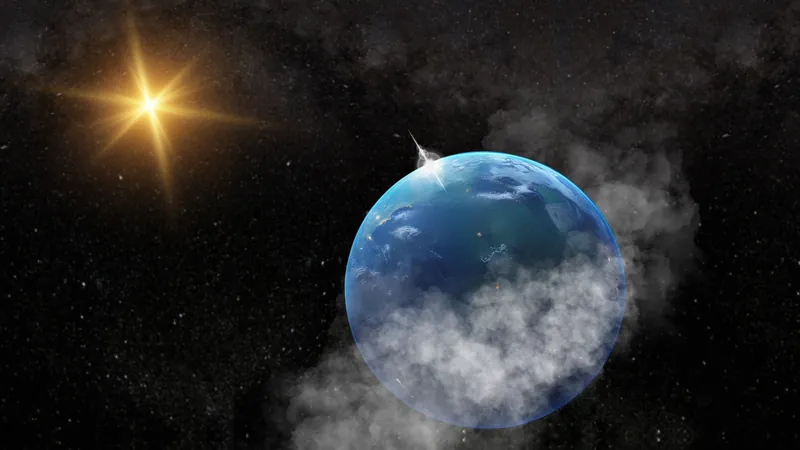
Revolutionary Insights on Steam Worlds: The Key to Unlocking Life Beyond Earth?
2025-08-26
Author: Wei Ling
The Rising Significance of Steam Worlds in Exoplanet Research
In an exciting breakthrough, scientists have unveiled a cutting-edge model to explore the fascinating realm of 'steam worlds'—exoplanets that lie between the sizes of Earth and Neptune. Due to their scorching temperatures, these planets lack liquid water on their surfaces, instead hosting thick atmospheres densely packed with water vapor. While steam worlds may not be the cradle of life, understanding them is crucial for refining our search for potentially habitable ocean planets.
Unveiling the Mysteries of Sub-Neptune Planets
Though absent from our solar system, sub-Neptune planets are the most common type of exoplanets discovered so far. These celestial bodies, often located closer to their stars than Earth is to the sun, are thought to be rich in water. However, their intense heat prevents the presence of liquid water on their surfaces, giving rise to exotic atmospheric phenomena.
A Game-Changing Model for Steam Worlds
A dedicated research team has developed a more precise approach for modeling these intriguing steam worlds, delving into their composition and origins. This innovative model considers water in its various exotic states—conditions that are challenging to reproduce on our home planet.
Artem Aguichine, the lead researcher from the University of California, Santa Cruz, emphasized that by grasping how these most abundantly observed planets form, scientists can shift their focus towards rarer exoplanets that may hold the key to life.
Webb’s Discovery Sparks New Interest
Interest in steam worlds surged following the James Webb Space Telescope's discovery of GJ 9827 d in October 2024, a planet twice the size of Earth, located about 100 light-years away, boasting an atmosphere filled almost entirely with water vapor. This marked the first confirmed observation of a steam world.
Since then, the JWST has identified steam in several other sub-Neptune atmospheres, intensifying the need for models that link their atmospheric conditions to their interiors.
Bridging the Gap Between Moons and Exoplanets
Previous models were typically designed for icy moons like Europa and Enceladus. However, considerable differences exist between these moons and sub-Neptune planets. With sub-Neptunes being significantly larger and closer to their stars, they possess steamy atmospheres rather than frigid outer shells.
Researchers have had to account for unique conditions, including supercritical water—a perplexing state that shares properties of both gases and liquids—and superionic ice, situations harder to simulate on Earth.
Implications for Future Discoveries
The newly developed model takes these exceptional states into account, providing a versatile tool for researching both current observations and potential evolutionary changes over billions of years.
The upcoming European Space Agency's Planetary Transit and Oscillation (PLATO) mission—scheduled for launch in 2026—aims to discover Earth-sized planets in habitable zones, aiding in validating these innovative models.
Aguichine notes, "PLATO will help us assess the accuracy of our predictions and guide further refinements in our models, shaping the next phase in the quest for extraterrestrial life."
A New Frontier in Astrobiology
The exploration of steam worlds could revolutionize our understanding of where life might thrive beyond our planet. Natalie Batalha, an astrobiologist involved in the study, states, "What we learn from these water worlds could unlock unforeseen applications and reveal novel niches for life in our galaxy."


 Brasil (PT)
Brasil (PT)
 Canada (EN)
Canada (EN)
 Chile (ES)
Chile (ES)
 Česko (CS)
Česko (CS)
 대한민국 (KO)
대한민국 (KO)
 España (ES)
España (ES)
 France (FR)
France (FR)
 Hong Kong (EN)
Hong Kong (EN)
 Italia (IT)
Italia (IT)
 日本 (JA)
日本 (JA)
 Magyarország (HU)
Magyarország (HU)
 Norge (NO)
Norge (NO)
 Polska (PL)
Polska (PL)
 Schweiz (DE)
Schweiz (DE)
 Singapore (EN)
Singapore (EN)
 Sverige (SV)
Sverige (SV)
 Suomi (FI)
Suomi (FI)
 Türkiye (TR)
Türkiye (TR)
 الإمارات العربية المتحدة (AR)
الإمارات العربية المتحدة (AR)